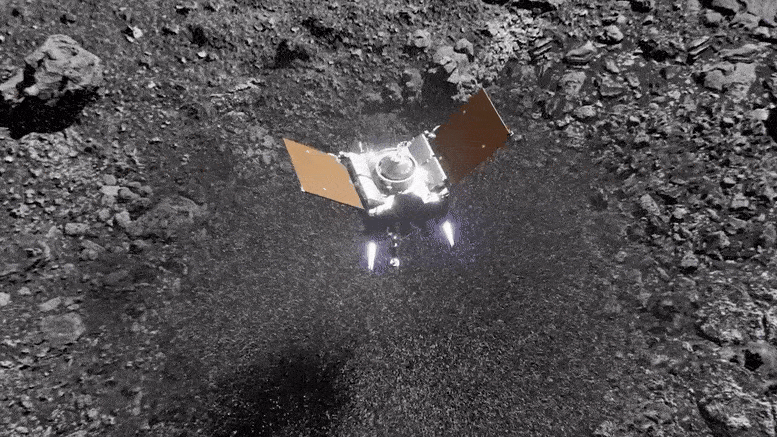Japanese scientists detected all 5 nucleobases — constructing blocks of DNA and RNA — in samples returned from asteroid Bennu by NASA’s OSIRIS-REx mission.
NASA’s OSIRIS-REx mission introduced again 121.6 grams of asteroid Bennu, unveiling nitrogen-rich natural matter, together with DNA’s important bases. Scientists discovered variations between Bennu’s chemistry and that of meteorites like Ryugu, suggesting various cosmic situations formed their molecular make-up.
Asteroids: Historic Messengers of Life?
Asteroids, small rocky our bodies within the interior Photo voltaic System, could have performed a key position in delivering water and important chemical components for all times to early Earth. Whereas meteorites that fall to Earth come from asteroids, their publicity to the environment and organic contamination makes them troublesome to check. The easiest way to investigate asteroid materials is by amassing pristine samples immediately from house. To date, solely two nations have efficiently accomplished this: Japan, with its Hayabusa and Hayabusa2 missions, and america, with OSIRIS-REx.
NASA’s OSIRIS-REx Brings Bennu to Earth
In September 2023, NASA’s OSIRIS-REx mission returned 121.6 grams of fabric from asteroid Bennu, the biggest asteroid pattern ever dropped at Earth. Now, a global analysis staff led by Dr. Daniel Glavin and Dr. Jason Dworkin at NASA’s Goddard Area Flight Heart has made a groundbreaking discovery: ammonia and nitrogen-rich natural compounds within the Bennu samples.
Their findings, revealed right now (January 29) in Nature Astronomy, add weight to the idea that asteroids could have helped kick-start life on Earth. Notably, Japanese researchers on the staff detected all 5 nitrogenous bases — key molecules wanted to type DNA and RNA — contained in the asteroid pattern, a discovery that strengthens the concept life’s constructing blocks could have originated in house.
The Bennu samples from NASA have been dealt with beneath nitrogen to stop contamination by Earth’s environment. A 17.75 mg pattern was processed and analyzed for N-heterocycles—natural molecules with a hoop construction containing carbon and nitrogen—utilizing high-resolution mass spectrometry at Kyushu College.

The evaluation was carried out by a analysis staff, whose members are a part of the OSIRIS-REx pattern evaluation staff, consisting of Affiliate Professor Yasuhiro Oba of Hokkaido College, Principal Researcher Yoshinori Takano of JAMSTEC and Keio College, Dr. Toshiki Koga of JAMSTEC, Professor Hiroshi Naraoka of Kyushu College, and Affiliate Professor Yoshihiro Furukawa of Tohoku College.
The evaluation revealed that the focus of N-heterocycles is roughly 5 nmol/g, 5-10 occasions greater than that reported from Ryugu. Along with the 5 nitrogenous bases — adenine, guanine, cytosine, thymine, and uracil — required for constructing DNA and RNA, the researchers additionally discovered xanthine, hypoxanthine, and nicotinic acid (vitamin B3).
“In earlier analysis, uracil and nicotinic acid have been detected within the samples from asteroid Ryugu, however the different 4 nucleobases have been absent. The distinction in abundance and complexity of N-heterocycles between Bennu and Ryugu might mirror the variations within the atmosphere to which these asteroids have been uncovered in house,” Koga explains.

Clues from Different Area Rocks
Samples from the meteorites Murchison and Orgueil have been additionally processed and analyzed beforehand beneath similar situations for comparability. The analysis staff noticed that the ratio of purines (adenine and guanine) to pyrimidines (cytosine, thymine, and uracil) was a lot decrease within the Bennu samples in comparison with each Murchison and Orgueil.
“There are a number of potential causes for this noticed distinction,” Oba says. “They could be as a consequence of variations in father or mother our bodies or formation pathways, or the Bennu asteroid was uncovered to a chilly molecular cloud atmosphere the place pyrimidine formation is extra prone to happen.”
“Our findings, which contribute to the bigger image painted by all of the authors of the paper, point out that nucleobase chemistry within the Bennu samples have to be additional studied,” concluded Naraoka. One other vital results of this examine is that, by evaluating meteorites with Bennu samples, a reference for the reanalysis of different meteorites in collections throughout the globe has been created.

Reference: “Plentiful ammonia and nitrogen-rich soluble natural matter in samples from asteroid (101955) Bennu” by Daniel P. Glavin, Jason P. Dworkin, Conel M. O’D. Alexander, José C. Aponte, Allison A. Baczynski, Jessica J. Barnes, Hans A. Bechtel, Eve L. Berger, Aaron S. Burton, Paola Caselli, Angela H. Chung, Simon J. Clemett, George D. Cody, Gerardo Dominguez, Jamie E. Elsila, Kendra Ok. Farnsworth, Dionysis I. Foustoukos, Katherine H. Freeman, Yoshihiro Furukawa, Zack Gainsforth, Heather V. Graham, Tommaso Grassi, Barbara Michela Giuliano, Victoria E. Hamilton, Pierre Haenecour, Philipp R. Heck, Amy E. Hofmann, Christopher H. Home, Yongsong Huang, Hannah H. Kaplan, Lindsay P. Keller, Bumsoo Kim, Toshiki Koga, Michael Liss, Hannah L. McLain, Matthew A. Marcus, Mila Matney, Timothy J. McCoy, Ophélie M. McIntosh, Angel Mojarro, Hiroshi Naraoka, Ann N. Nguyen, Michel Nuevo, Joseph A. Nuth III, Yasuhiro Oba, Eric T. Parker, Tanya S. Peretyazhko, Scott A. Sandford, Ewerton Santos, Philippe Schmitt-Kopplin, Frederic Seguin, Danielle N. Simkus, Anique Shahid, Yoshinori Takano, Kathie L. Thomas-Keprta, Havishk Tripathi, Gabriella Weiss, Yuke Zheng, Nicole G. Lunning, Kevin Righter, Harold C. Connolly Jr. and Dante S. Lauretta, 29 January 2025, Nature Astronomy.
DOI: 10.1038/s41550-024-02472-9


